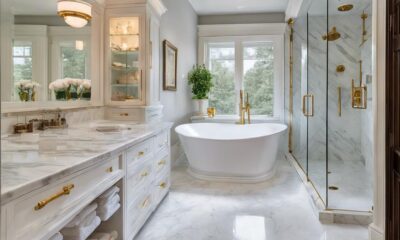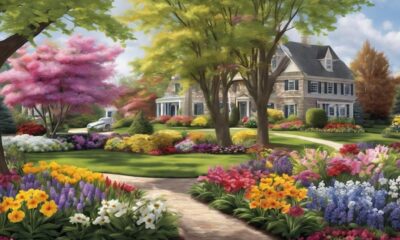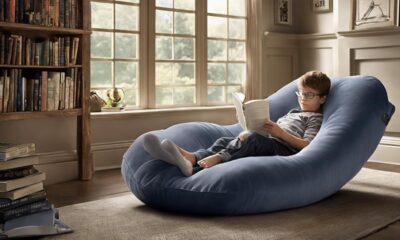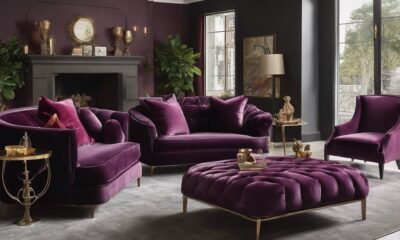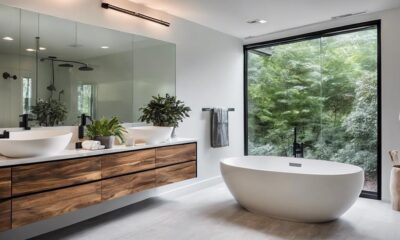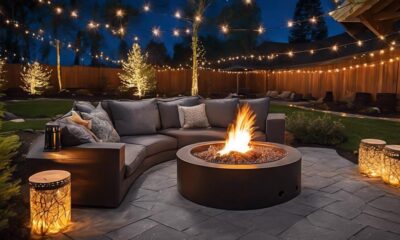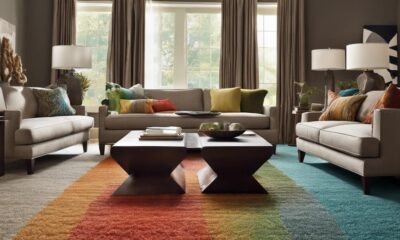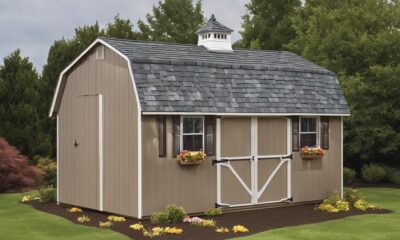Decor
What Is the Meaning of Spring Couplets?
2025
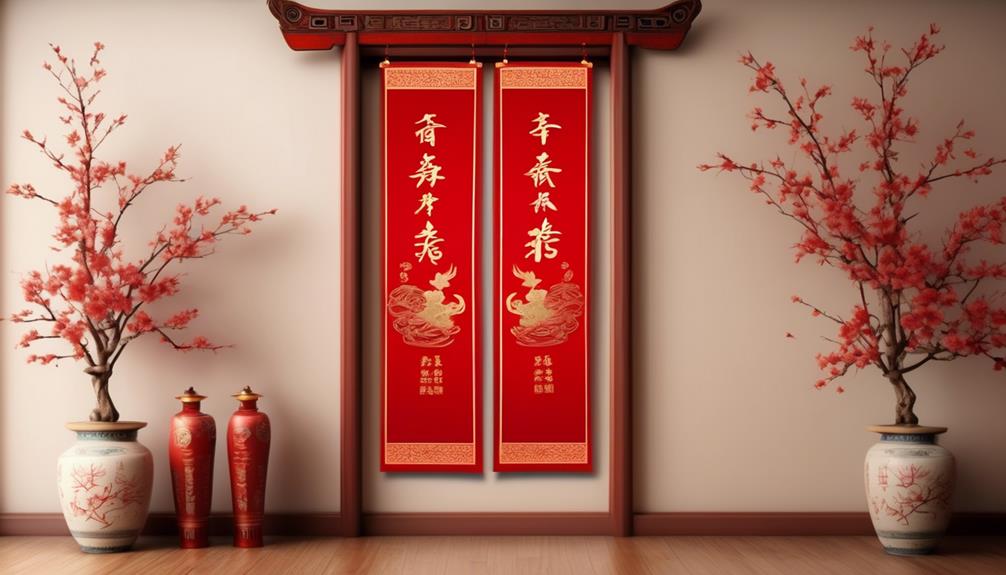
In exploring the importance of spring couplets, we delve into a profound tradition steeped in cultural symbolism and artistic creativity.
These decorative pieces hold a deeper meaning that resonates with various aspects of life and the changing seasons.
Key Takeaways
- Spring couplets have a rich cultural heritage dating back to the Song Dynasty and have evolved over time, reflecting cultural traditions.
- The colors red and gold symbolize good luck, happiness, prosperity, and success, and are prominently featured in spring couplets.
- Calligraphy techniques play a crucial role in creating spring couplets, requiring patience, practice, and attention to detail.
- Regional variations in materials, designs, and writing styles exist, reflecting the unique historical and cultural significance of each region.
Origins of Spring Couplets
The origins of spring couplets can be traced back to ancient Chinese traditions and customs. Dating back to the Song Dynasty, the chunlian tradition has evolved over time, reflecting the rich cultural heritage of China.
The color symbolism meanings in spring couplets are significant, with red symbolizing good luck and happiness, while gold represents prosperity and fortune. Calligraphy techniques play a crucial role in the creation of these couplets, with skilled artisans using brush and ink to craft intricate characters with elegance and precision.
Traditional auspicious symbols such as the Fu character are commonly featured, representing blessings and good fortune. Regional variations add diversity to the tradition, each area incorporating unique elements into the design and content of the couplets.
Spring couplets also hold deep cultural significance, symbolizing family reunion and the arrival of spring. They're often adorned with Chinese poetry, adding literary beauty to the auspicious messages.
Efforts to preserve this tradition are gaining global recognition, emphasizing the importance of safeguarding this invaluable aspect of Chinese heritage.
Evolution of Chunlian Tradition
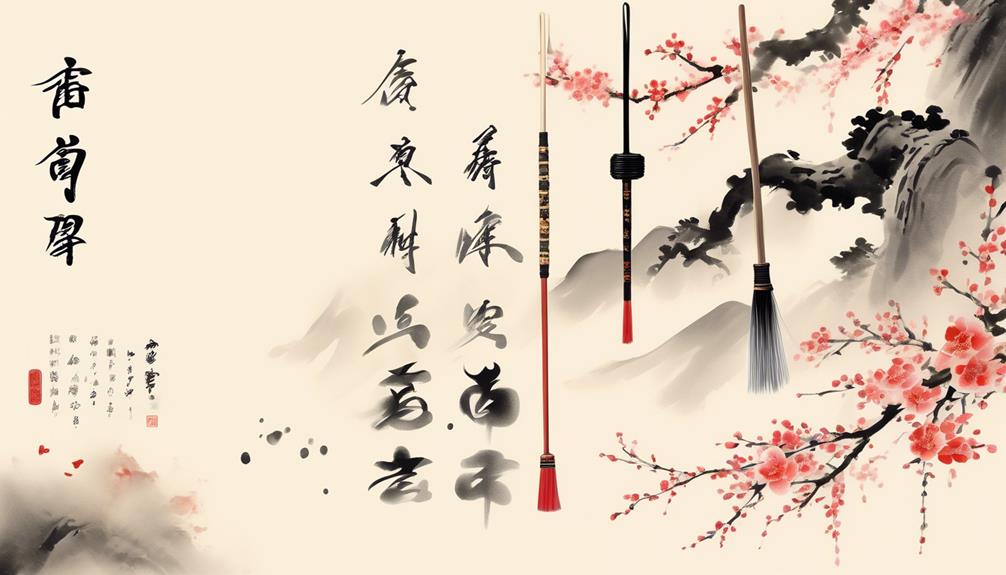
During the evolution of the Chunlian tradition, significant changes in materials and techniques have shaped the modern practice of creating spring couplets. The evolution of Chunlian has been influenced by various factors, leading to its current form, which reflects both tradition and modernity.
- Cultural Significance: Over time, the cultural significance of Chunlian has expanded beyond its traditional role of bringing good luck to encompass themes such as family harmony, prosperity, and personal aspirations.
- Regional Variations: Different regions in China have developed their unique styles and customs related to Chunlian, resulting in diverse regional variations in materials, designs, and calligraphy styles.
- Modern Interpretations: In contemporary society, artists and calligraphers have introduced innovative approaches to Chunlian, incorporating modern themes, artistic techniques, and even digital mediums to create spring couplets that resonate with modern sensibilities.
- Influence of Globalization: The evolution of Chunlian has also been impacted by globalization, with the tradition spreading to other countries and cultures, leading to new interpretations and adaptations of the practice.
The evolution of Chunlian reflects the dynamic nature of cultural traditions, as it continues to adapt and thrive in the modern world while retaining its deep cultural roots.
Symbolism of Red and Gold
We all know that red symbolizes luck and gold represents wealth. These colors hold deep cultural significance in many Asian societies.
Understanding the symbolism of red and gold is essential to appreciating the meaning behind Spring Couplets.
Red Symbolizes Luck
Symbolizing good fortune and prosperity, the vibrant color red is deeply ingrained in Chinese culture and tradition, especially during festive occasions. Red symbolizes luck in Chinese tradition due to its association with positive energy, vitality, and celebration.
Here's why red is a symbol of luck:
- Positive Energy: Red is believed to attract positive energy and ward off negative forces.
- Vitality and Celebration: The color red is associated with vitality, passion, and joy, symbolizing the liveliness and excitement of celebratory events.
- Prosperity and Good Fortune: Red is often used in traditional Chinese weddings and during the Lunar New Year to symbolize prosperity and good fortune for the future.
- Protection from Evil: Red is also thought to provide protection from evil spirits and bad luck.
The use of red in various cultural and traditional contexts reflects its deep-rooted symbolism in Chinese society.
Gold Represents Wealth
Glittering in the sunlight, gold embodies wealth and prosperity in traditional Chinese culture and is often used in festive decorations and attire. The symbolism of gold represents not only material wealth but also spiritual abundance and good fortune. In Chinese culture, the color gold is associated with the earth element and symbolizes the fulfillment of life. It is believed to attract positive energy and bring good luck. The cultural significance of gold as a representation of wealth is deeply rooted in traditional Chinese values and is prominently featured in various celebrations and rituals. From weddings to New Year's festivities, the use of gold accents signifies prosperity and success. This symbolism of wealth is intricately woven into the fabric of Chinese traditions, reinforcing the importance of abundance and fortune in people's lives.
| Symbolism of Gold Represents Wealth |
|---|
| Material Wealth |
| Spiritual Abundance |
| Good Fortune |
Color Symbolism Meanings
The cultural significance of gold as a representation of wealth in traditional Chinese culture seamlessly extends to the symbolism of red and gold in various celebrations and rituals.
In Chinese culture, the colors red and gold hold deep symbolic meanings that have evolved over centuries, rooted in historical traditions and beliefs.
- Color Symbolism: Red symbolizes good fortune, joy, and happiness in Chinese culture.
- Cultural Significance: These colors are prominently featured during Chinese New Year, weddings, and other significant events.
- Evolution: The symbolism of red and gold has evolved to represent prosperity, luck, and success.
- Historical Roots: These colors have been integral to Chinese culture for thousands of years, reflecting the enduring values and beliefs of the society.
The rich symbolism of red and gold continues to play a vital role in Chinese traditions, embodying auspicious meanings and cultural heritage.
Calligraphy and Artistry
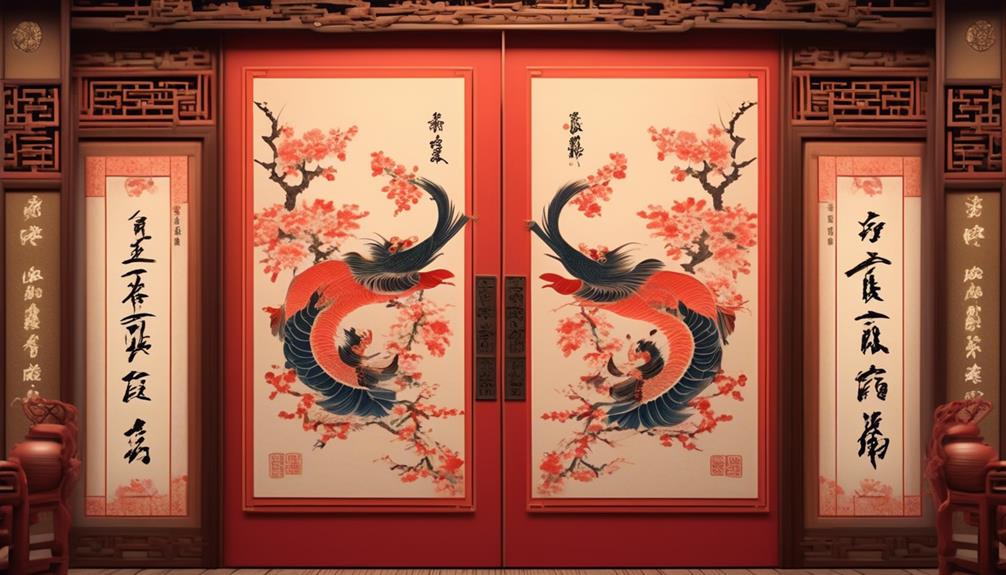
Let's explore the artistry and calligraphy techniques used in creating Spring Couplets.
The intricate brushstrokes and symbolism in the artwork add depth and meaning to the couplets.
Understanding the artistic elements will enhance our appreciation of the cultural significance behind each character and design.
Calligraphy Techniques
Mastering calligraphy techniques requires patience, practice, and a keen eye for detail. Brush techniques are foundational, encompassing strokes, pressure variation, and wrist control. Achieving artistic flair involves mastering the balance between fluidity and precision.
Historical significance provides a rich foundation, inspiring contemporary relevance. Understanding traditional scripts and their evolution allows for innovative interpretations while respecting heritage. Studying the masters' work and emulating their techniques is crucial for skill development.
Experimenting with different tools and surfaces expands artistic expression and fosters versatility. Acquiring an understanding of composition and layout enhances the visual impact of calligraphy. Engaging with diverse styles and cultural contexts broadens creativity and fosters a deeper appreciation for the art form.
Continuous learning and adaptation are essential for honing calligraphy skills and achieving mastery.
Symbolism in Art
Exploring the symbolism in calligraphy and artistry allows us to delve deeper into the cultural significance of traditional scripts and their evolution, providing a richer understanding of the art form.
Symbolism interpretation in calligraphy and artistry is an essential aspect of mastering these art forms. Calligraphy isn't just about writing; it's a form of artistic expression where strokes, sizes, and styles convey deeper meanings. In traditional Chinese calligraphy, for instance, the choice of characters and the flow of the brush reflect the artist's emotions and intentions.
Similarly, in visual art, the use of colors, shapes, and composition carries symbolic significance. Understanding these symbols enhances our appreciation of the artwork and the cultural context it represents.
Mastery of symbolism in calligraphy and artistry enables artists to communicate profound messages and emotions through their work.
Selection of Auspicious Phrases
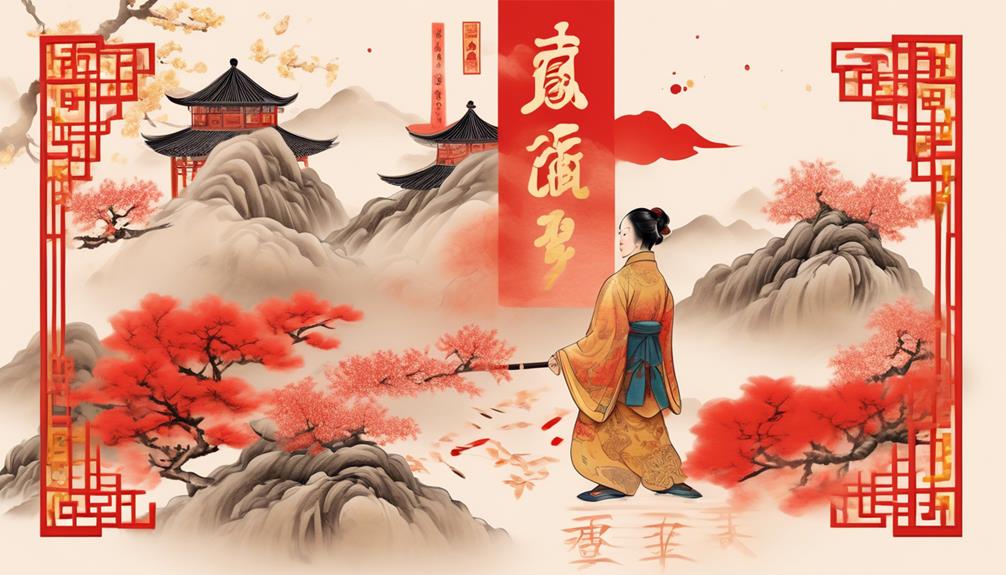
We carefully select auspicious phrases to infuse our spring couplets with positive energy and blessings. The cultural significance of these auspicious phrases can't be overstated. They're carefully chosen to bring good fortune, prosperity, and happiness to the household. Our selection process involves deep consideration of traditional meanings and modern interpretations, ensuring that the phrases resonate with both the past and the present.
Here's how we choose these auspicious phrases:
- Historical Relevance: We delve into historical texts and classical literature to find timeless phrases that have been used for centuries to convey blessings and well-wishes.
- Symbolic Meaning: Each word and character is meticulously analyzed for its symbolic significance, ensuring that the entire couplet is rich with positive connotations.
- Cultural Context: We consider the cultural context in which the couplets will be displayed, ensuring that the chosen phrases are relevant and meaningful to the specific community or family.
- Artistic Harmony: The selected phrases mustn't only carry positive energy but also flow artistically, creating a harmonious blend of visual beauty and linguistic elegance.
Placement and Timing

Let's talk about where to place spring couplets, when to put them up, and the traditional symbols that are often included.
The location for couplets, the timing for their placement, and the use of traditional auspicious symbols all play a significant role in the overall impact and meaning of these decorations.
We'll explore how these elements contribute to the rich tradition of spring couplets.
Location for Couplets
filled with blessings and good fortune.
The decorative elements of the couplets add to the overall ambiance of the household during the Spring Festival.
Timing for Placement
After placing the couplets on both sides of the front door to welcome the new year and bring good luck to the household, the timing for their placement becomes crucial, as they're usually put up on New Year's Eve to symbolize the beginning of a new year filled with blessings and good fortune.
The cultural significance of this timing is rooted in the festive traditions and customs of Chinese New Year. Placing the couplets at this specific time is believed to ensure that the household is embraced by luck and prosperity right from the start of the new year.
It's a deeply ingrained practice, reflecting the importance of ushering in the new year with auspicious symbols and positive energy. Understanding the significance of this timing adds depth to the appreciation of the spring couplets' role in Chinese New Year celebrations.
Traditional Auspicious Symbols
Placing traditional auspicious symbols, such as the spring couplets, at specific times holds great significance in Chinese New Year celebrations, as it's believed to usher in luck and prosperity from the start of the new year. Understanding the cultural significance of these symbols enhances the overall experience of the celebration.
Here are some key points to consider:
- Proper Placement: Auspicious symbols should be prominently displayed on the doors or walls of homes during the Chinese New Year.
- Timing: The ideal time to put up these symbols is before the New Year's Eve dinner, as it signifies welcoming good fortune and warding off negative energy.
- Symbolic Meanings: Each traditional auspicious symbol carries deep cultural meanings, representing blessings, longevity, happiness, and prosperity.
- Renewal and Hope: These symbols symbolize a fresh start, renewing hopes for a prosperous year ahead.
Understanding the significance of these symbols enriches the cultural experience and adds depth to the Chinese New Year celebrations.
Regional Variations
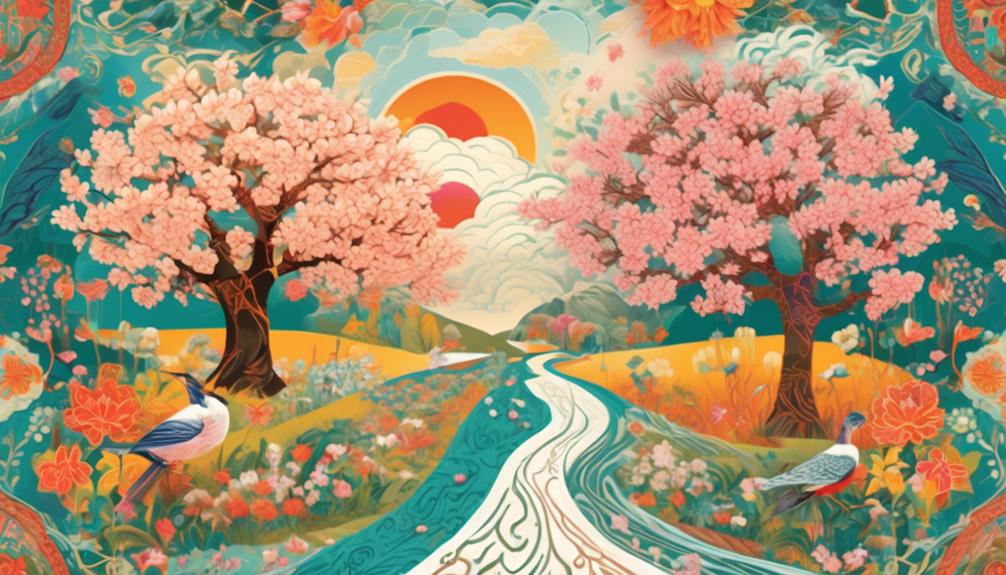
Spring couplets exhibit regional variations in both content and style, reflecting the diversity of cultural traditions across different areas of China. These variations are deeply rooted in the unique historical and cultural significance of each region.
For example, in northern China, the content of spring couplets often emphasizes blessings for a good harvest, prosperity, and family reunion, while in southern China, the focus is more on expressing good wishes for the upcoming year and warding off evil spirits. Additionally, the style of writing can vary significantly, with different regions showcasing distinct calligraphic techniques and artistic expressions.
The regional variations in spring couplets serve as a testament to the rich tapestry of Chinese culture, highlighting the influence of geography, history, and local customs on this cherished tradition. People across China take pride in these regional differences, celebrating the cultural diversity that has shaped the art of spring couplets.
Understanding these variations not only offers insight into the depth of Chinese traditions but also fosters a greater appreciation for the interconnectedness of regional cultures within the nation.
Role in Family Reunion
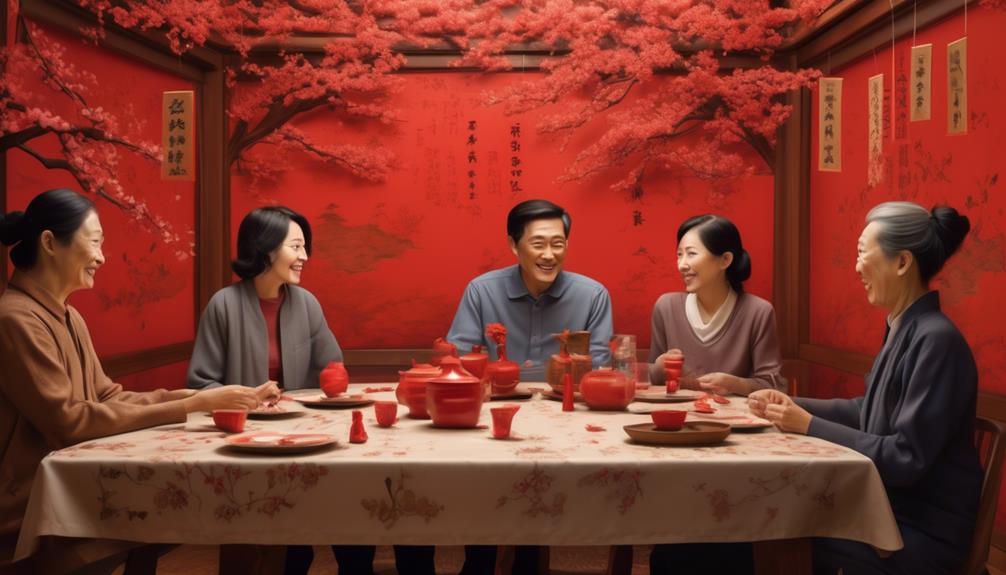
Spring couplets play an important role in our family reunion traditions. They symbolize luck and prosperity, and we often use them to decorate our doorways during the Spring Festival.
This custom not only brings a festive atmosphere to our homes but also signifies the importance of family unity and togetherness during this special time of year.
Symbol of Luck
In our family, the couplets symbolize luck and play a significant role in our joyous reunions. They hold cultural significance and are considered luck symbols that bring prosperity and good fortune. The spring couplets, prominently displayed in our home, are believed to attract positive energy and ward off negativity.
During family reunions, the couplets create a festive atmosphere and serve as a reminder of our shared values and traditions. The vibrant red color and auspicious phrases on the couplets uplift our spirits and set the tone for a harmonious gathering. As we gather around the couplets, we feel a sense of unity and optimism, strengthening our familial bonds.
Through the couplets, we celebrate our heritage and express our hopes for a prosperous and joyful future.
- Luck symbols
- Prosperity and good fortune
- Festive atmosphere
- Strengthening familial bonds
Decorate Doorways
During our family reunions, adorning the doorways with vibrant red spring couplets creates a festive and auspicious atmosphere, setting the tone for a harmonious gathering. This festive tradition is deeply rooted in Chinese culture and holds significant symbolic meanings. The doorway decoration serves as a welcoming beacon, symbolizing good luck, prosperity, and happiness for the upcoming year. The use of red color signifies joy and fortune, while the poetic verses on the couplets convey well-wishes and blessings. Below is a table depicting the symbolic meanings of the doorway decoration:
| Symbolic Meanings | |
|---|---|
| Red Color | Joy, Fortune |
| Spring Couplets | Well-wishes, Blessings |
| Adorning Doorways | Welcoming Beacon, Good Luck, Prosperity |
Connection to Chinese Poetry
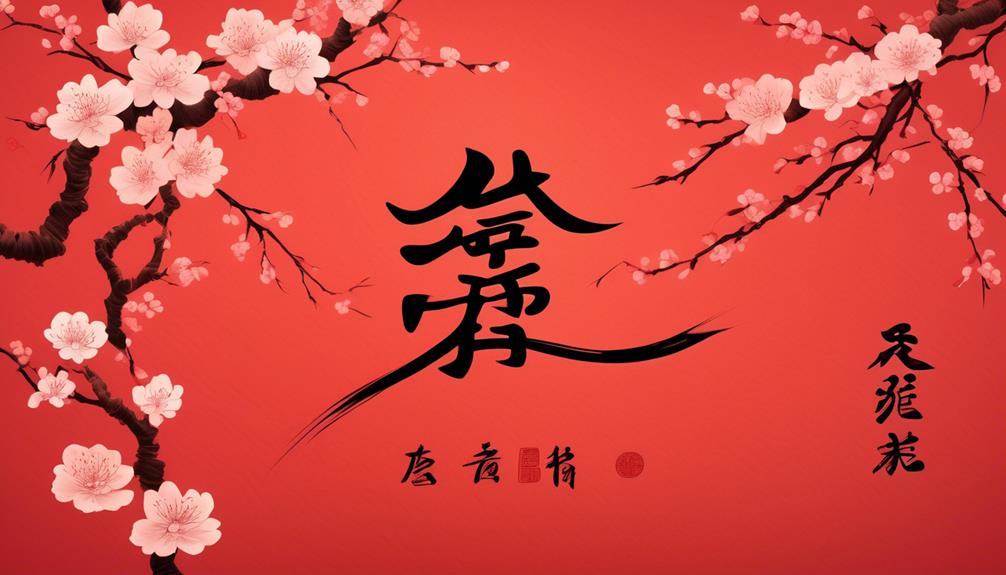
Chinese poetry is intricately intertwined with the tradition of spring couplets, reflecting the cultural significance of this art form in the Chinese New Year celebrations. The connection to Chinese poetry is deeply rooted in the historical significance of both the poetry and the spring couplets.
Here's how spring couplets are connected to Chinese poetry:
- Literary Tradition: Chinese poetry has a rich literary tradition that spans thousands of years, and spring couplets draw inspiration from these classical poems, often incorporating poetic elements such as rhyme, rhythm, and symbolism.
- Historical Significance: Throughout history, Chinese poets have used their verses to celebrate the arrival of spring, the beauty of nature, and the hopes for a prosperous new year, themes that are also reflected in spring couplets.
The use of poetic language in spring couplets adds layers of meaning and cultural depth to the tradition, making it not just a decorative custom, but a continuation of the rich poetic heritage that has been cherished for centuries.
Superstitions and Taboos

Drawing from the rich literary tradition and historical significance of Chinese poetry, we can explore the superstitions and taboos associated with the practice of spring couplets.
In Chinese culture, certain taboos and beliefs surround the creation and display of spring couplets during the Lunar New Year. It's believed that the couplets shouldn't be hung upside down, as this is considered extremely unlucky. Additionally, using words with negative connotations, such as 'death,' 'illness,' or 'loss,' is avoided in the couplets to prevent bringing bad luck into the home.
The cultural significance of spring couplets also extends to the timing of their removal. It's customary to take down the old couplets before the Lunar New Year and replace them with new ones, symbolizing a fresh start and the welcoming of good fortune in the coming year.
These taboos and beliefs are deeply rooted in Chinese traditions and reflect the importance of auspicious symbols and positive energy in the celebration of the Lunar New Year.
Modern Interpretations
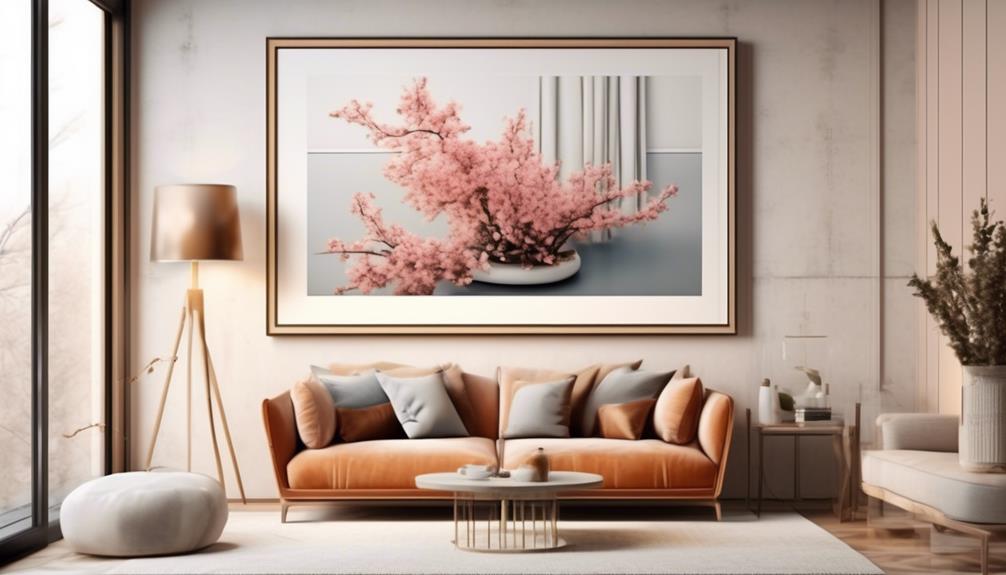
In modern times, people have reinterpreted the traditional practice of spring couplets to reflect contemporary themes and values. This reinterpretation has allowed the spring couplets to remain relevant in today's society. Some modern interpretations and contemporary practices of spring couplets include:
- Social Justice: Spring couplets are now used to promote social justice and equality, advocating for human rights and environmental conservation.
- Personal Growth: Individuals use spring couplets to set personal goals and affirmations for the upcoming year, focusing on self-improvement and mental well-being.
- Global Awareness: With the increasing interconnectedness of the world, spring couplets are being used to express solidarity with global issues and promote cultural diversity.
- Technology Integration: Modern interpretations involve incorporating technological references and advancements into the couplets, reflecting the digital age and its impact on society.
These contemporary themes and values reflect the changing societal landscape and demonstrate the versatility of spring couplets in adapting to modern contexts.
As a result, the practice continues to thrive and evolve, resonating with people of diverse backgrounds and beliefs in today's world.
Impact on Home Decor
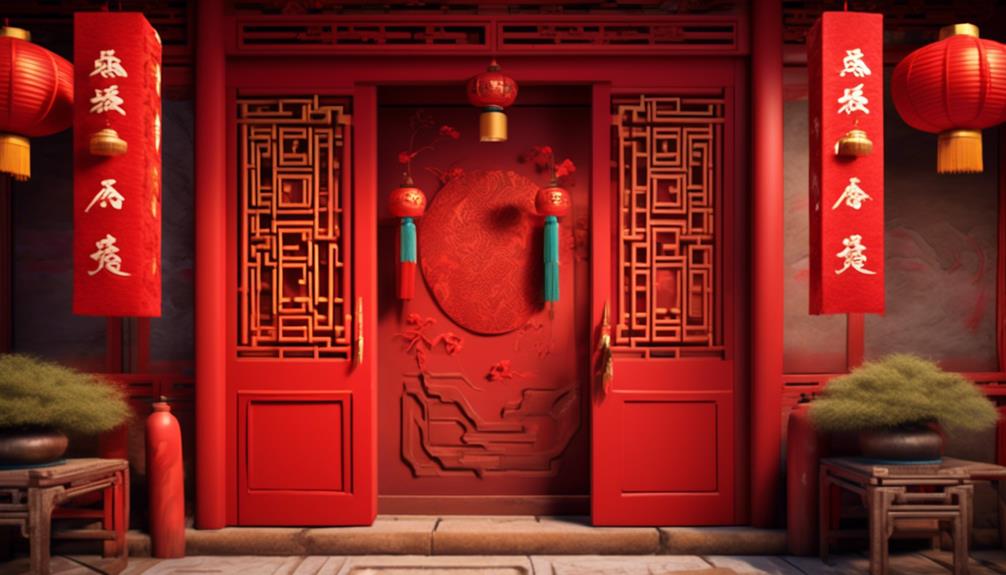
The presence of spring couplets in our home decor adds a touch of cultural richness and auspicious symbolism to our living spaces. When considering home renovation or interior design, incorporating spring couplets can elevate the overall aesthetic and create a harmonious atmosphere. Not only do they serve as decorative elements, but they also carry deep cultural significance, making them a meaningful addition to any home.
To better understand the impact of spring couplets on home decor, let's explore their role in interior design and home renovation.
| Pros | Cons |
|---|---|
| Adds cultural richness | Requires proper placement |
| Symbolizes auspiciousness | Choosing appropriate size |
| Creates harmonious atmosphere | Matching with existing decor |
| Reflects meaningful tradition | Finding suitable frames |
Incorporating spring couplets into home decor not only enhances the visual appeal but also infuses spaces with tradition and cultural significance. When carefully integrated into interior design, these auspicious couplets can truly elevate the ambiance of any living space, making them a valuable addition to home renovation projects.
Cultural Preservation Efforts
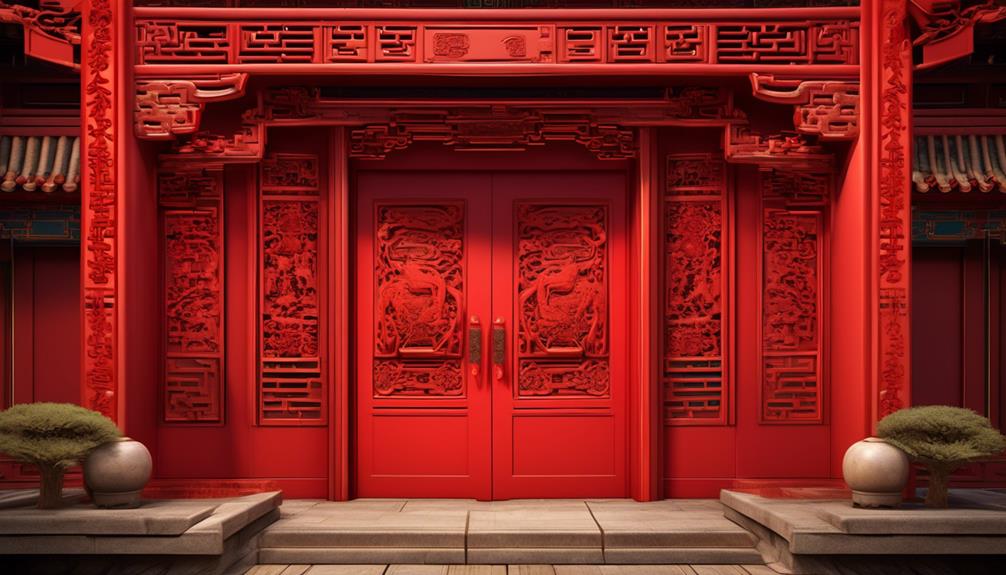
Preserving cultural traditions like incorporating spring couplets into home decor is essential for maintaining the richness of our heritage and ensuring its continuity for future generations. Cultural preservation efforts play a crucial role in safeguarding the significance of spring couplets and other traditional practices.
The following strategies are instrumental in these endeavors:
- Education and Awareness: Increasing public understanding of the cultural significance of spring couplets through educational programs and workshops.
- Documentation and Research: Conducting thorough research and documentation to preserve the historical context and evolution of spring couplets.
- Community Engagement: Involving local communities in the creation and display of spring couplets to foster a sense of ownership and continuity.
- Government Support: Garnering support from government bodies to allocate resources and initiatives for the preservation and promotion of spring couplets.
These preservation efforts are vital in ensuring that the cultural significance of spring couplets is upheld and passed down to future generations. By actively engaging in these initiatives, we contribute to the longevity and appreciation of our rich cultural heritage.
Global Recognition and Adoption
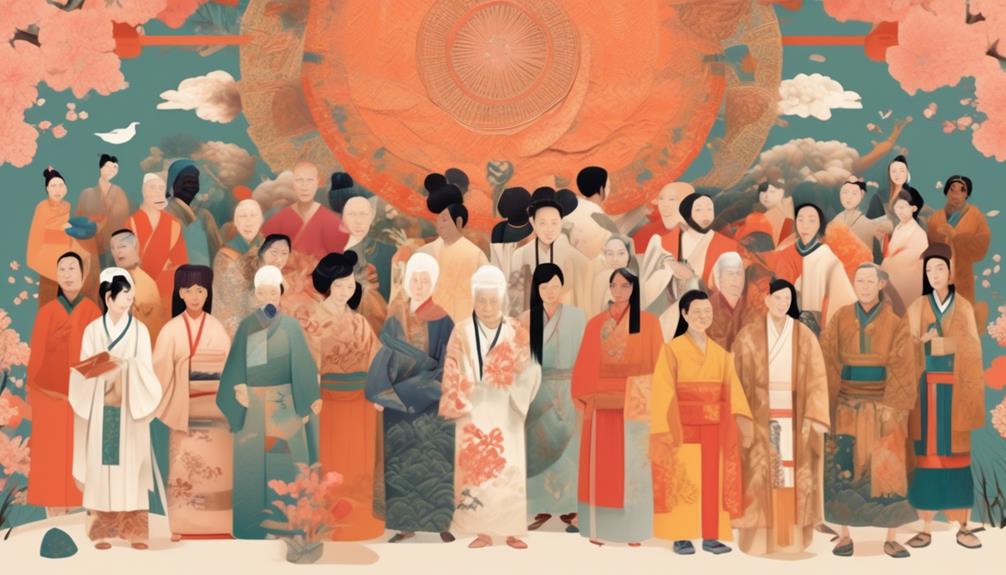
Engaging with diverse cultures and embracing global traditions enriches our understanding and appreciation of spring couplets. The global influence of spring couplets is evident in the way different cultures across the world have recognized and adopted this traditional Chinese art form. The symbolism in art, represented through the auspicious messages and decorative designs of spring couplets, has resonated with people of various backgrounds, leading to its widespread adoption in diverse regions. This global recognition hasn't only expanded the reach of spring couplets but also deepened the cultural significance attached to them.
The adoption of spring couplets in different parts of the world reflects the universal appeal of the art form and its ability to transcend cultural boundaries. As individuals from various cultural backgrounds incorporate spring couplets into their celebrations and decorations, they contribute to the preservation and evolution of this ancient tradition. The global influence of spring couplets serves as a testament to the enduring power of symbolism in art, demonstrating how traditional Chinese customs can find resonance and appreciation in a global context.
Frequently Asked Questions
What Are Some Common Mistakes to Avoid When Choosing and Hanging Spring Couplets?
When choosing and hanging spring couplets, it's important to avoid common mistakes. These mistakes include mismatching traditional designs or placing them in inappropriate locations. Stick to common themes and consider placement tips to ensure they create the desired effect.
Avoiding these mistakes will help you fully embrace the cultural significance and beauty of spring couplets.
How Has the Tradition of Spring Couplets Evolved in Contemporary Chinese Society?
In contemporary Chinese society, the tradition of spring couplets has evolved significantly. Modern influence has brought about new themes and artistic styles, reflecting the changing values and aspirations of the people.
Evolution in materials and production techniques has also enriched the art form. These developments have helped keep the tradition relevant and vibrant, demonstrating its ability to adapt and resonate with the current generation.
Are There Any Specific Rules or Guidelines for Creating Your Own Spring Couplets?
Creating spring couplets allows for creative expression and holds cultural significance in Chinese tradition. While there are no strict rules, historical origins and symbolic meanings guide the process.
Each couplet typically consists of two lines, with a specific rhythm and poetic structure. It's a unique opportunity for artistic and linguistic mastery, as individuals craft their own couplets to reflect their hopes and aspirations for the new year.
How Do Spring Couplets Tie Into Other Traditional Chinese New Year Decorations and Customs?
Spring couplets tie into other traditional Chinese New Year decorations and customs through their symbolism and significance. They complement lanterns, paper cuttings, and door gods, adding to the festive atmosphere.
While traditional designs reflect cultural heritage, modern interpretations showcase creativity and innovation. Understanding these connections enriches our appreciation of the New Year traditions, bridging the gap between past and present.
It's an essential aspect of mastering the cultural depth of Chinese New Year celebrations.
What Are Some Lesser-Known Cultural Traditions or Customs Related to Spring Couplets?
When it comes to spring couplets, there are a myriad of lesser-known cultural traditions and customs. Regional variations in wording and artistic styles abound, reflecting the diverse cultural tapestry of China.
These couplets hold deep symbolic meanings, often rooted in historical origins and rich folklore. Exploring these traditions unveils a treasure trove of artistic expression and historical significance.
How Can Spring Couplets be Used to Symbolize the Cherry Blossom Tree?
Spring couplets can be used to symbolize the beauty and transience of cherry blossom trees. The couplets are often adorned with poetic phrases and images that evoke the delicate and ephemeral nature of the cherry blossom tree symbolism, making them the perfect complement to the fleeting beauty of the blossoms.
Conclusion
As we unravel the layers of history, symbolism, and tradition behind spring couplets, we're reminded of their profound significance.
Like the delicate blossoms of a cherry tree, the Chunlian tradition blooms with cultural richness and artistic beauty.
The red and gold hues symbolize prosperity and good fortune, while the calligraphy and artistry elevate the couplets to a form of visual poetry.
They aren't just decorations, but a window into the soul of a vibrant and enduring cultural heritage.
- About the Author
- Latest Posts
Introducing Ron, the home decor aficionado at ByRetreat, whose passion for creating beautiful and inviting spaces is at the heart of his work. With his deep knowledge of home decor and his innate sense of style, Ron brings a wealth of expertise and a keen eye for detail to the ByRetreat team.
Ron’s love for home decor goes beyond aesthetics; he understands that our surroundings play a significant role in our overall well-being and productivity. With this in mind, Ron is dedicated to transforming remote workspaces into havens of comfort, functionality, and beauty.
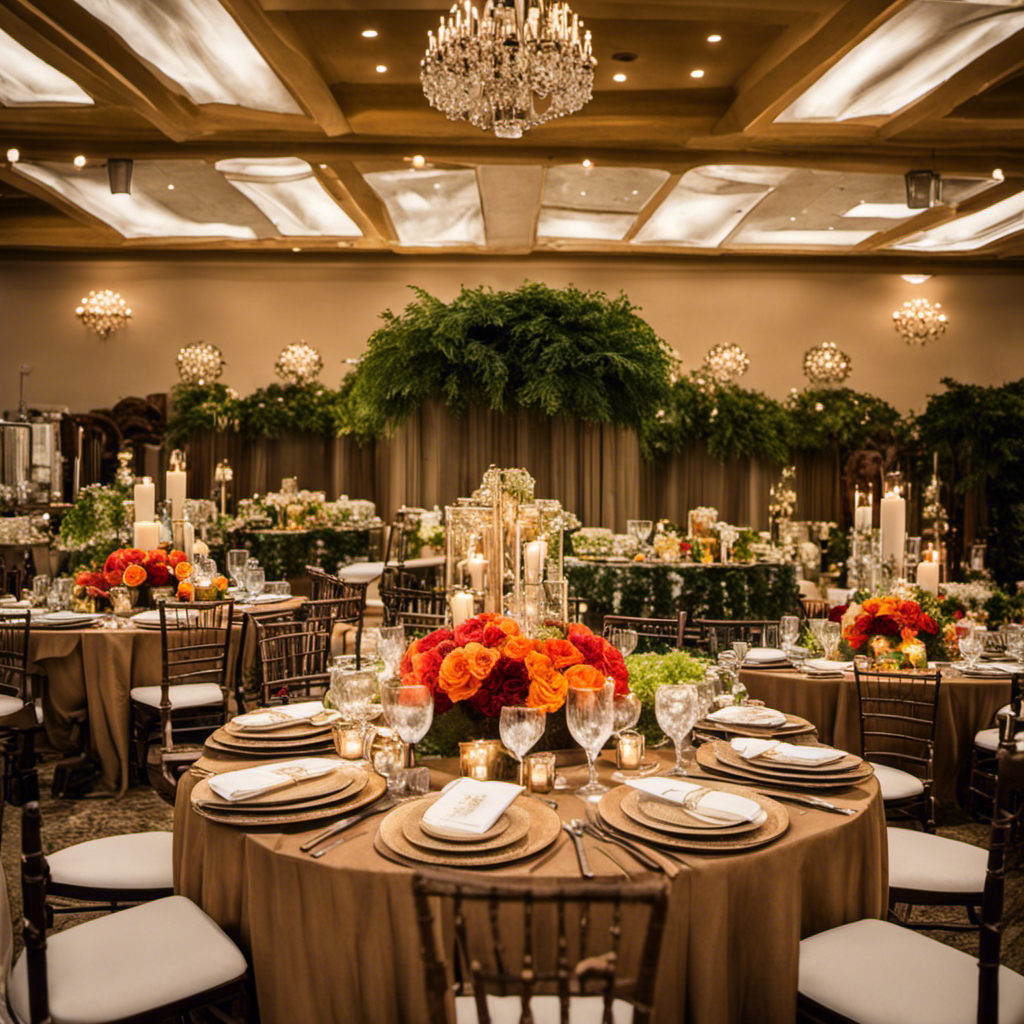
Want to add some style to your dining table? You’re in for a treat!
Hobby Lobby, the mecca of all things crafty, has got some fantastic deals on table decor. Yes, you heard that right – the place where your creative dreams come true is also a treasure trove for finding amazing discounts on that perfect centerpiece or charming place settings.
So, grab your shopping list and get ready to be amazed by the fabulous sales and savings awaiting you at Hobby Lobby.
Key Takeaways
- Hobby Lobby offers a wide variety of table decor styles, including farmhouse-inspired pieces, burlap table runners, and elegant crystal centerpieces.
- Seasonal sales at Hobby Lobby provide discounted prices on table decorations, with themes such as a Rustic Winter Wonderland, Whimsical Christmas, and Elegant New Year’s Eve.
- The best times to shop for table decor deals at Hobby Lobby are during seasonal sales and holiday promotions, where you can find budget-friendly options and get inspired by DIY ideas.
- Strategies for finding table decor discounts at Hobby Lobby include checking online retailers and signing up for newsletters, looking for affordable DIY ideas, repurposing everyday items, and taking advantage of clearance sales and seasonal promotions.
Types of Table Decor on Sale
There’s a wide variety of table decor on sale at Hobby Lobby right now.
When it comes to table decor, you’ll find different styles to suit your taste and popular themes to match any occasion.
If you’re looking for a rustic vibe, there are charming farmhouse-inspired pieces like distressed wooden candle holders and burlap table runners.
For a more glamorous touch, you can choose from elegant crystal centerpieces and shimmering sequin tablecloths.
Hobby Lobby also offers table decor for specific themes, such as beach parties or holiday gatherings.
From seashell-shaped napkin rings to Christmas-themed table runners, you’ll find everything you need to set the perfect ambiance.
And the best part? These table decor items are often included in seasonal sales, allowing you to save money while transforming your table into a stunning focal point.
Seasonal Sales for Table Decor
During the holiday season, you can find discounted prices on seasonal table decorations at Hobby Lobby. It’s the perfect time to spruce up your dining table and create a festive atmosphere for your guests.
Here are three popular themes for table decor during seasonal sales:
-
Rustic Winter Wonderland: Embrace the charm of a cozy cabin in the woods with natural elements like pinecones, birch logs, and plaid accents. Add a touch of sparkle with silver or gold candle holders and twinkling fairy lights.
-
Whimsical Christmas: Bring out your inner child with playful decor featuring Santa Claus, reindeer, and snowmen. Create a centerpiece with a snow globe or a DIY snowflake garland using craft paper and glitter.
-
Elegant New Year’s Eve: Ring in the new year in style with a glamorous table setting. Opt for metallic accents, such as gold or silver charger plates, sequined table runners, and crystal candle holders.
With these creative DIY table decor ideas for any budget, you can transform your dining table into a stunning focal point for your holiday gatherings.
Now, let’s talk about the best times to shop for table decor deals…
Best Times to Shop for Table Decor Deals
If you want to snag the best deals on table decor, you should keep an eye out for seasonal sales and holiday promotions. These are the times when you can find budget-friendly table decor ideas and get inspired by DIY table decor projects.
During these sales, stores like Hobby Lobby often offer discounts on a variety of table decor items, from centerpieces to place settings. You can find inspiration for creating your own unique table decor by browsing through DIY blogs and Pinterest boards.
By utilizing these budget-friendly ideas and getting creative with DIY projects, you can transform your table into a stunning focal point without breaking the bank.
Now, let’s explore some strategies for finding table decor discounts without compromising on style and quality.
Strategies for Finding Table Decor Discounts
To find discounts on table decor, you should consider checking online retailers and signing up for their newsletters. This way, you’ll be the first to know about any upcoming sales or exclusive promotions.
Here are some strategies to help you find the best deals:
-
Look for affordable DIY table decor ideas: Get creative and make your own centerpieces and place settings using materials you already have at home. Not only will this save you money, but it will also add a personal touch to your table.
-
Explore creative ways to repurpose everyday items as table decor: Turn mason jars into candle holders, use vintage books as a unique centerpiece, or repurpose wine corks into place card holders. The possibilities are endless!
-
Keep an eye out for clearance sales and seasonal promotions: Many online retailers offer discounted prices on table decor items at the end of each season or during special occasions like Black Friday or Cyber Monday.
By utilizing these strategies, you can find affordable table decor options that suit your style and budget.
Now, let’s move on to some insider tips for maximizing savings on table decor.
Insider Tips for Maximizing Savings on Table Decor
One way to maximize savings on table decor is by taking advantage of online coupon codes and promotions.
When planning a budget-friendly event, it’s important to find creative and cost-effective ways to decorate your tables.
DIY table decor ideas are a great way to add a personal touch while saving money.
Look for online retailers that offer coupon codes and discounts specifically for table decor items.
These promotions can help you get the best deals on budget-friendly centerpieces, table runners, and other decor items.
Additionally, consider using natural elements and repurposed materials for your DIY table decor.
For example, you can create stunning centerpieces using flowers from your own garden or repurpose old mason jars as vases.
Frequently Asked Questions
Are There Any Specific Table Decor Items That Are Never on Sale at Hobby Lobby?
When it comes to specific table decor items that are never on sale at Hobby Lobby, it’s hard to say for sure without more information. However, the best time to buy table decor items is usually during their seasonal sales.
How Often Does Hobby Lobby Restock Their Table Decor Items?
When it comes to restocking table decor at Hobby Lobby, they do it regularly to ensure you have a wide selection. This allows you to style your table for different occasions and find affordable items.
Can I Use Coupons or Promotional Codes on Table Decor Items During Sales?
During sales at Hobby Lobby, you can definitely use coupons or promotional codes to get discounts on table decor items. It’s a great way to save money while still adding that special touch to your home.
Are There Any Restrictions on the Quantity of Table Decor Items That Can Be Purchased During Sales?
During sales at Hobby Lobby, there may be quantity restrictions on table decor items. However, it’s important to note that the availability of these items online could vary.
Does Hobby Lobby Offer Any Price Matching for Table Decor Items?
Hobby Lobby does not offer price matching for table decor items. However, you can find discounted table decor items at other home decor stores like Michaels, Joann, or even online retailers like Amazon or Wayfair.
Conclusion
Congratulations on making it to the end of the article! Now that you’re armed with all the insider tips and strategies for finding the best deals on table decor at Hobby Lobby, it’s time to put your newfound knowledge to use.
Whether you’re looking for seasonal sales or simply want to snag a great deal, remember to keep an eye out for those irresistible discounts.
So go ahead, start planning your next shopping trip and let your creative side shine as you transform your dining table into a masterpiece, all while saving some serious cash.
Happy shopping!
- About the Author
- Latest Posts
Meet Katherine, the creative enthusiast at ByRetreat who infuses her boundless passion for design into every remote workspace she crafts. With an innate sense of creativity and an eye for unconventional beauty, Katherine brings a unique and inspiring perspective to the team.
Katherine’s love for design is infectious, and her ability to think outside the box sets her apart. She believes that true artistry lies in embracing a variety of styles and mixing them harmoniously to create captivating spaces. By combining different textures, colors, and patterns, Katherine weaves a tapestry of creativity that breathes life into each remote workspace.

Are you seeking to give your living room a brand new appearance? Search no more!
In this article, we will guide you through the process of decorating your living room, step by step. From choosing the perfect color scheme to arranging your furniture in the most optimal way, we’ve got you covered.
Get ready to transform your space into a stylish and inviting haven that reflects your personal taste and style.
Let’s dive in and create the living room of your dreams!
Key Takeaways
- Choose colors wisely to create the desired mood in your living room
- Arrange furniture strategically to maximize space and create a cozy atmosphere
- Use decorative accessories to enhance the style and ambiance of the room
- Incorporate plants and greenery to add a fresh and calming touch to your living room.
Choosing the Right Color Scheme
Choosing the right color scheme for your living room can completely transform the overall atmosphere. Color psychology plays a significant role in influencing mood, so it’s important to choose colors that align with the atmosphere you want to create.
For example, cool colors like blue and green can promote a sense of calmness and relaxation, while warm colors like red and orange can create a more energetic and vibrant ambiance.
To add visual interest to your living room, consider using accent colors. These are bold, contrasting colors that can be incorporated through accessories, such as throw pillows, artwork, or curtains. Accent colors can help create focal points and add depth to the space.
Now that you have the perfect color scheme, let’s move on to furniture arrangement and placement.
Furniture Arrangement and Placement
When arranging and placing furniture, make sure you consider the flow and functionality of the space. This is crucial for creating a harmonious and inviting living room. Here are three key tips to keep in mind:
-
Focal point placement: Identify the focal point of your room, such as a fireplace or a large window, and arrange your furniture around it. This will create a natural flow and draw attention to the central feature.
-
Maximize small spaces: If you have a small living room, choose furniture that serves multiple purposes, like a coffee table with built-in storage or a sofa that can be converted into a bed. Use vertical storage solutions, such as wall-mounted shelves, to make the most of limited floor space.
-
Create conversation areas: Arrange your furniture in a way that encourages conversation and interaction. Place seating options facing each other, with a coffee table or ottoman in between. This will make your living room feel cozy and inviting.
By considering these tips, you can create a functional and visually appealing furniture arrangement in your living room.
Now, let’s move on to adding decorative accessories to enhance the overall look and feel.
Adding Decorative Accessories
To enhance the overall look and feel of your space, consider adding decorative accessories like throw pillows, rugs, and wall art. These simple additions can make a big impact on the style and ambiance of your living room.
When it comes to wall art selection, choose pieces that complement your existing color scheme and reflect your personal taste and interests. Whether you prefer abstract paintings, vintage posters, or family photographs, wall art can add personality and visual interest to your walls.
Additionally, stylish throw pillows can instantly elevate the comfort and style of your furniture. Opt for pillows in coordinating colors and patterns to create a cohesive look.
Now that you’ve added these decorative touches, let’s move on to lighting tips and tricks to further enhance your living room’s atmosphere.
Lighting Tips and Tricks
Now that you’ve added those decorative accessories, it’s time to consider how lighting can enhance the ambiance of your space.
Creative lighting fixtures play a crucial role in transforming your living room into a cozy and inviting sanctuary. Think outside the box and opt for unique fixtures that not only illuminate the room but also serve as statement pieces. Whether it’s a chandelier, pendant lights, or floor lamps, let your creativity shine through.
Additionally, don’t underestimate the importance of natural light. It not only brightens up the room but also creates a sense of openness and freshness. Make the most of windows and skylights by using sheer curtains or blinds that allow plenty of sunlight to filter in.
Now, let’s explore how incorporating plants and greenery can further elevate your living room’s aesthetic.
Incorporating Plants and Greenery
Don’t forget to bring life into your space by incorporating plants and greenery. Indoor gardening not only adds a fresh and vibrant touch to your living room, but it also comes with numerous benefits. Plants have the power to purify the air, reduce stress levels, and boost your mood. They add a natural element to your decor, creating a calming and peaceful atmosphere.
To help you choose the perfect plants for your living room, here is a table showcasing a variety of options:
| Plant Name | Light Requirements | Care Level |
|---|---|---|
| Snake Plant | Low to medium | Easy |
| Peace Lily | Low to medium | Moderate |
| Spider Plant | Low to medium | Easy |
| Pothos | Low to medium | Easy |
Frequently Asked Questions
How Can I Incorporate My Personal Style Into the Color Scheme of My Living Room?
Incorporate your personal style into the color scheme of your living room by choosing decorative accessories that reflect your taste. Consider adding pillows, curtains, or artwork in colors and patterns that you love.
What Are Some Furniture Arrangement Tips for Small Living Rooms?
To maximize space in small living rooms, consider furniture placement. Opt for multi-functional pieces like a sofa bed or a coffee table with storage. Use floating shelves and wall-mounted TV to free up floor space.
How Do I Choose the Right Decorative Accessories That Complement My Living Room’s Style?
Choosing the right decorative accessories for your living room’s style can be daunting, but it’s essential for a visually appealing space. Consider budget-friendly options and mixing patterns to create a cohesive look.
What Are Some Creative Lighting Ideas to Make My Living Room Feel Cozy and Inviting?
To create a cozy and inviting atmosphere in your living room, consider creative lighting ideas. Use warm, dimmable lights, like string lights or table lamps, to add a soft glow and create a relaxing ambiance.
Are There Any Specific Types of Plants or Greenery That Are Low-Maintenance and Suitable for Indoor Living Spaces?
Looking for low-maintenance indoor plants? You’re in luck! There are plenty of greenery options that thrive in small spaces. From succulents to snake plants, these beauties will add life and vibrancy to your living room.
Can the Same Decor Principles be Applied to Both Living and Boiler Rooms?
When it comes to decorating a broiler room, the same principles of functionality and aesthetics apply as they do in a living room. While the decor may vary in style, both spaces can benefit from thoughtful organization, proper lighting, and the inclusion of personal touches to create a welcoming atmosphere.
– How Can I Incorporate Fall Decorations into My Living Room Design?
Transforming your living room for fall is easy with these 10 easy fall decor ideas. Start with warm, earthy tones in your throw pillows and blankets. Add in some rustic elements like wooden accents and decorative pumpkins. Don’t forget to incorporate autumn-inspired artwork and scented candles for a cozy ambiance.
Conclusion
So there you have it. By following these simple tips and tricks, you can transform your living room into a stunning and inviting space.
With the right color scheme, furniture arrangement, and decorative accessories, you can create a room that reflects your personal style and makes a statement.
Don’t forget to play with lighting to create the perfect ambiance, and consider incorporating plants and greenery for a touch of nature.
Get ready to impress your guests and enjoy a beautifully decorated living room that you can truly call your own.
- About the Author
- Latest Posts
Meet Katherine, the creative enthusiast at ByRetreat who infuses her boundless passion for design into every remote workspace she crafts. With an innate sense of creativity and an eye for unconventional beauty, Katherine brings a unique and inspiring perspective to the team.
Katherine’s love for design is infectious, and her ability to think outside the box sets her apart. She believes that true artistry lies in embracing a variety of styles and mixing them harmoniously to create captivating spaces. By combining different textures, colors, and patterns, Katherine weaves a tapestry of creativity that breathes life into each remote workspace.
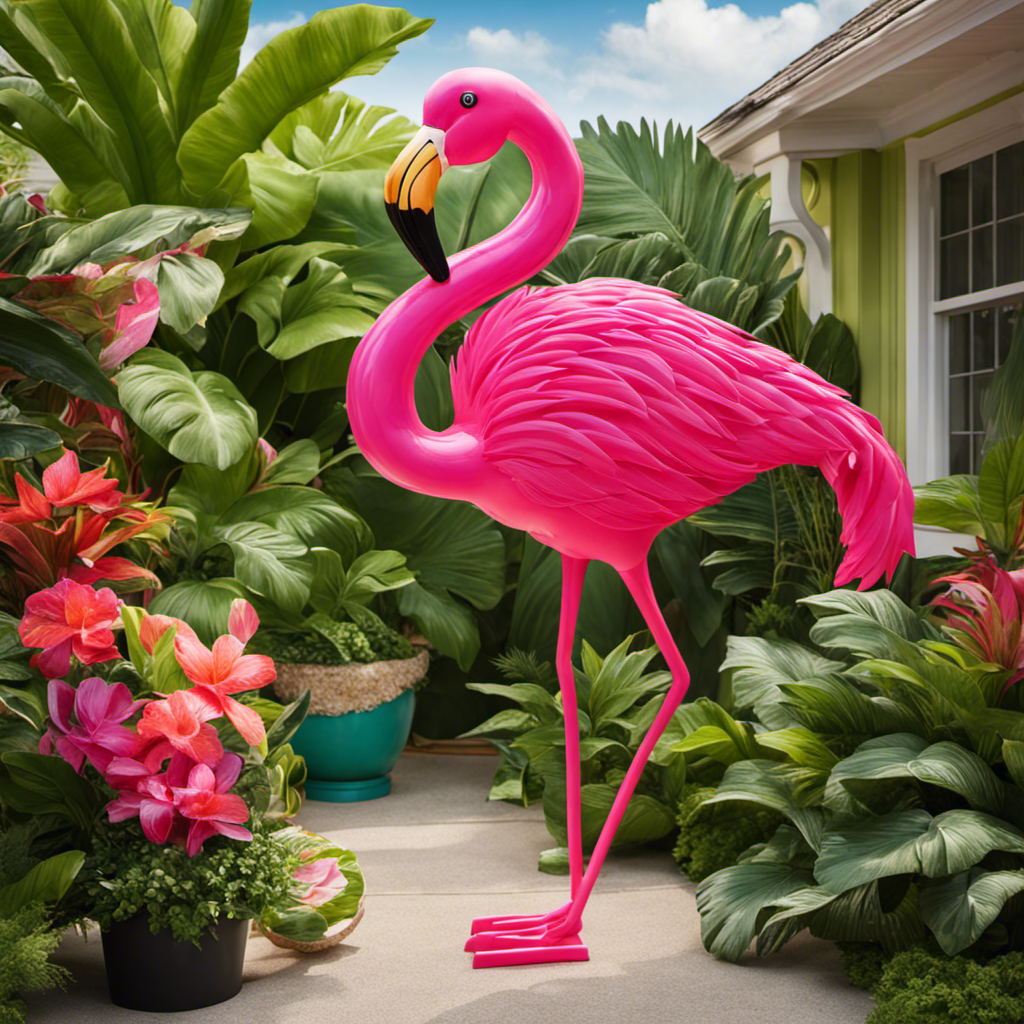
Ever thought about what it says about you to have a flamingo as porch decor?
—
Translation in English (United States): Ever thought about what it says about you to have a flamingo as porch decor?
Well, you’re in luck because in this article, I will delve into the symbolism, historical significance, and cultural meanings behind this unique choice of ornament.
We will also explore the psychological interpretation of flamingo decor and its connection to personal style and taste.
So, if you’re curious to uncover the hidden messages behind those vibrant pink birds on your porch, keep reading to discover what it truly means.
Key Takeaways
- Flamingos as porch decor symbolize elegance, grace, and a sense of tropical paradise and relaxation.
- Flamingos reflect personal values and desires, adding depth and meaning to living spaces.
- Having flamingo decor brings a sense of beauty, joy, and playfulness, enhancing psychological well-being.
- Flamingo decor showcases unique personal style, adds whimsy, and serves as a trendy conversation starter.
The Symbolism of Flamingos as Porch Decor
Having a flamingo as porch decor can symbolize whimsy and a carefree attitude. Flamingos have their historical origins in ancient Egypt, where they were considered a symbol of the sun god Ra. They were also associated with fertility and rebirth.
In modern times, flamingos have become popular as decorative items, representing a desire for fun and relaxation. The bright pink color of flamingos adds a vibrant touch to any porch, creating a cheerful and inviting atmosphere.
Psychologically, the presence of flamingos can evoke feelings of joy, playfulness, and freedom. The sight of a flamingo on the porch can instantly uplift one’s mood and remind them to embrace the lighter side of life.
Understanding the historical origins and psychological symbolism of flamingos helps us appreciate their significance in home decoration.
Historical Significance of Flamingos in Home Decoration
The historical significance of flamingos in home decoration can be traced back to ancient civilizations. These majestic birds have long been considered a symbolic representation of beauty and grace. In various cultures, flamingos have been associated with qualities such as elegance, balance, and harmony. Their vibrant pink color and unique shape make them a popular choice for adding a touch of whimsy to any porch or garden.
| Symbolic Representation | Cultural Influences |
|---|---|
| Beauty | Ancient Egypt |
| Grace | Mediterranean |
| Elegance | Caribbean |
| Balance | South America |
| Harmony | Southeast Asia |
Throughout history, people have been drawn to the allure of flamingos, incorporating them into their homes as a way to express their appreciation for nature and the natural world. As we delve deeper into the cultural meanings attached to flamingo porch decor, we will explore the various ways in which these symbols have influenced our lives and continue to bring joy and inspiration to our homes.
Cultural Meanings Attached to Flamingo Porch Decor
When you incorporate flamingo porch decor into your home, you’ll discover the rich cultural meanings attached to these vibrant symbols. Flamingos have been admired and revered by various cultures throughout history, and their presence as porch ornaments can carry profound symbolic interpretations.
Here are three cultural significances of flamingo porch decor:
-
Elegance and Grace: Flamingos are known for their graceful movements and striking appearance. Having them as porch decor reflects a desire for elegance and sophistication in one’s living space.
-
Tropical Paradise: Flamingos are often associated with tropical destinations and exotic landscapes. Incorporating them into your porch decor can evoke a sense of relaxation and escape, bringing a touch of paradise to your home.
-
Symbol of Love and Romance: In some cultures, flamingos symbolize love and monogamy. By displaying them on your porch, you are expressing a commitment to love and creating a romantic atmosphere in your home.
As you can see, the cultural significance of flamingo porch decor goes beyond mere decorative purposes. It adds depth and meaning to your living space, reflecting your personal values and desires.
Now, let’s explore the psychological interpretation of flamingos as porch ornaments.
Psychological Interpretation of Flamingo as Porch Ornament
As I delve into the psychological interpretation of the flamingo as a porch ornament, I find myself fascinated by the symbolic meaning behind this whimsical creature.
The flamingo, with its vibrant colors and graceful stance, represents beauty, grace, and elegance.
In terms of psychological effects, the presence of a flamingo ornament can evoke feelings of joy, relaxation, and a sense of playfulness, creating a positive and welcoming atmosphere for both the homeowners and their guests.
Symbolic Meaning of Flamingo
If you have a flamingo as porch decor, it means you’re embracing a symbol of beauty, balance, and grace. The flamingo holds a deep symbolic interpretation and spiritual significance. Placing a flamingo on your porch not only adds a vibrant pop of color but also invites a sense of joy and positivity to your space. These elegant birds are often associated with community and connection, reminding us to find harmony in our relationships and surroundings. With flamingo decor symbolism explained, it becomes clear that this choice of decoration goes beyond aesthetics, reflecting a deeper appreciation for life’s beauty and balance.
Here are three reasons why having a flamingo as porch decor can bring a sense of meaning and connection to your surroundings:
-
Elegance: The graceful posture and slender physique of the flamingo represent elegance and refinement. By displaying a flamingo on your porch, you are incorporating these qualities into your own space, creating an atmosphere of sophistication.
-
Balance: The flamingo’s ability to stand on one leg symbolizes balance and stability. It serves as a reminder to find equilibrium in our lives, both physically and mentally. Having a flamingo as porch decor can inspire a sense of grounding and harmony.
-
Beauty: With its vibrant pink feathers and striking appearance, the flamingo exudes beauty. By choosing a flamingo as porch decor, you are celebrating the beauty of nature and bringing a touch of enchantment to your outdoor space.
Psychological Effects of Ornament
To fully understand the psychological effects of ornament, you can explore how it enhances your mood and perception of your surroundings. Ornaments, such as decorative objects or symbols, play a significant role in our daily lives. They have the power to evoke emotions, create a sense of belonging, and reflect our personal style and taste. The symbolism of ornaments can vary greatly, from representing cultural traditions to expressing individual beliefs. By incorporating ornaments into our living spaces, we can create a visually stimulating environment that promotes positive emotions and enhances our overall well-being. For example, a table adorned with a vase of fresh flowers or a shelf displaying cherished family photos can instantly uplift our mood and create a sense of comfort and happiness. The psychological impact of ornaments is vast and unique to each individual, making them an essential aspect of our daily lives.
| Symbolism | Psychological Impact |
|---|---|
| Flowers | Uplifting and joy |
| Family Photos | Nostalgia and connection |
| Artwork | Inspiration and creativity |
| Religious Symbols | Spiritual comfort and peace |
| Nature-inspired decor | Tranquility and harmony |
Incorporating ornaments that hold personal meaning and significance can have a profound impact on our psychological well-being. They serve as visual reminders of our values, beliefs, and memories, creating a sense of identity and belonging. Whether it’s a religious symbol that brings us comfort or a nature-inspired decor that promotes tranquility, ornaments have the power to evoke emotions and shape our perception of our surroundings. Understanding the psychological effects of ornament allows us to curate our living spaces intentionally, creating an environment that aligns with our personal style and taste.
Transitioning into the subsequent section about ‘flamingo decor: a reflection of personal style and taste,’ we can explore how incorporating flamingo-themed ornaments can be a unique way to express ourselves and add a touch of whimsy to our living spaces.
Flamingo Decor: A Reflection of Personal Style and Taste
Decorating your porch with a flamingo instantly showcases your unique personal style and taste. The choice to incorporate this iconic bird into your outdoor decor is a deliberate one, as it adds a symbolic flair and represents an expressive personality.
Here are three reasons why having a flamingo on your porch is a great way to express yourself:
-
Quirkiness: Flamingos are known for their vibrant pink color and long, slender legs. By displaying a flamingo on your porch, you are showing your love for the unconventional and embracing your own quirkiness.
-
Playfulness: Flamingos are often associated with a sense of fun and playfulness. Having one as porch decor is a way to bring a lighthearted and whimsical touch to your home.
-
Tropical vibes: Flamingos are often found in tropical environments, so having them on your porch can create a sense of vacation and relaxation. It adds a touch of the exotic to your outdoor space.
With these reasons in mind, it’s clear that decorating your porch with a flamingo is more than just a trendy choice – it’s a reflection of your personality and style.
Flamingo Decor: A Trendy Choice for Modern Homeowners
Flamingo decor has become increasingly popular among modern homeowners due to its trendy and fashionable appeal. It is not surprising to see these elegant, long-legged birds making their way into our homes as a symbol of style and creativity.
Flamingo decor trends have taken the design world by storm, adding a touch of whimsy and tropical charm to modern home aesthetics. From vibrant flamingo prints on throw pillows and wall art to sleek and sophisticated flamingo-shaped furniture pieces, there is no shortage of options for incorporating these graceful creatures into your home decor.
With their vibrant colors and graceful postures, flamingos bring a sense of joy and relaxation to any space. They serve as a reminder to embrace the beauty of nature and create a welcoming and visually stunning environment.
Speaking of stunning environments, let’s now explore how flamingo porch decor can be a conversation starter or icebreaker.
Flamingo Porch Decor: A Conversation Starter or Icebreaker
Flamingo porch decor can instantly create a lively and engaging atmosphere for your outdoor space. Here’s why it’s a conversation starter and a curiosity sparkler:
-
Eye-catching: Flamingo porch decor stands out with its vibrant hues and unique design. Passersby can’t help but notice and comment on these whimsical bird statues, starting conversations effortlessly.
-
Symbol of Fun: Flamingos are often associated with tropical vibes, summer vacations, and relaxation. Having them as porch decor sets a playful tone and sparks curiosity about the stories behind them.
-
Unexpected Surprise: Flamingos are not commonly seen in everyday decor, making them a delightful surprise for guests. Their presence on your porch signals a touch of individuality and creativity, inviting others to admire and inquire about your personal style.
With flamingos as porch decor, your outdoor space becomes a captivating sanctuary, showcasing your unique taste and inviting others to join in the fun.
Let’s explore why flamingos make such a statement.
Flamingos as Porch Decor: A Sign of Individuality and Creativity
When it comes to porch decor, nothing makes a statement quite like a unique and eye-catching piece. Whether it’s a vibrant flamingo statue or a whimsical flamingo-themed wind chime, incorporating these elegant birds into your porch design can symbolize your personal style and taste.
Not only does it add a touch of individuality to your outdoor space, but it also embraces artistic expression, allowing you to showcase your creativity and love for all things unique.
Unique Porch Statement
If you want to make a unique porch statement, adding a flamingo as porch decor can really make a bold and eye-catching statement. Flamingos are not only beautiful birds, but they also symbolize elegance and grace.
Here are three reasons why incorporating a flamingo into your porch design can create a truly unique and creative outdoor decor:
-
Vibrant and Playful: Flamingos are known for their vibrant pink color and whimsical appearance. By placing a flamingo on your porch, you instantly infuse a sense of playfulness and fun into your outdoor space.
-
Tropical Vibes: Flamingos are often associated with tropical destinations and warm weather. By incorporating a flamingo into your porch design, you can create a tropical oasis right at your doorstep, bringing a touch of vacation vibes to your home.
-
Conversation Starter: A flamingo porch decor is a great conversation starter. Whether it’s a unique statue or a colorful flamingo wind chime, it will undoubtedly catch the attention of your guests and spark interesting conversations about your personal style and love for nature.
Symbolizing Personal Style
Incorporating a flamingo into your porch design can be a unique way to showcase your personal style and add a touch of elegance to your outdoor space.
Flamingos have long been associated with grace, beauty, and individuality, making them a perfect choice for those seeking to express their unique taste. The symbolic interpretation of a flamingo can vary, but many see it as a representation of balance and harmony.
By including a flamingo in your porch decor, you are not only adding a visually striking element, but also sending a message of self-expression and embracing your own individuality. This bold choice invites conversations and admiration from guests, further enhancing the welcoming atmosphere of your porch.
Embracing artistic expression in your home allows you to create a space that reflects your personality and brings joy to all who visit.
Embracing Artistic Expression
Embracing artistic expression in your home allows you to create a space that reflects your personality and brings joy to all who visit. Incorporating personal expression and a connection with nature can transform your home into a sanctuary of creativity and tranquility. Here are three ways to embrace artistic expression in your home:
-
Display nature-inspired artwork: Hang paintings or photographs that depict the beauty of the natural world. This can evoke a sense of calm and serenity while also showcasing your love for nature.
-
Incorporate natural elements: Bring the outdoors inside by adding plants, flowers, or even a small indoor garden. These elements not only enhance the aesthetic appeal, but also create a connection with nature.
-
DIY projects: Get your creative juices flowing by making your own artwork or decor. Whether it’s painting, crafting, or upcycling furniture, these projects allow for personal expression and add a unique touch to your home.
By embracing artistic expression and incorporating a connection with nature, you can create a home that not only reflects your personality but also promotes a sense of harmony and tranquility.
Now, let’s explore how flamingo porch decor symbolizes the connection to nature and wildlife.
Flamingo Porch Decor and Its Connection to Nature and Wildlife
Flamingo porch decor can serve as a reminder of our connection to nature and wildlife. It not only adds a vibrant touch to our homes but also symbolizes our appreciation for these magnificent creatures.
Flamingos are known for their distinctive pink feathers and graceful demeanor, and they have captured the hearts of many. However, it is important to consider the environmental impact of porch decor.
While flamingo conservation efforts are crucial in protecting these birds and their habitats, the production and disposal of decorative items can contribute to waste and pollution. Therefore, it is essential to choose sustainable options, such as using recycled materials or supporting eco-friendly brands.
Frequently Asked Questions
What Are Some Common Materials Used in Making Flamingo Porch Decor?
Different types of flamingo porch decor designs can be made using materials such as metal, plastic, and wood. I know where to buy these materials, and I can provide detailed information about each option.
Are There Any Specific Color Variations That Are Popular for Flamingo Porch Decor?
Popular color variations for flamingo porch decor range from vibrant pink to pastel hues. Incorporating these trendy colors into your porch decor can add a playful and whimsical touch, reflecting current interior design trends.
How Do People Typically Display Flamingo Porch Decor?
People typically display flamingo porch decor in various creative ways. Some popular options include placing them on the porch railing, using them as lawn ornaments, or positioning them near potted plants. It adds a fun and vibrant touch to outdoor spaces.
Are There Any Superstitions or Beliefs Associated With Having Flamingo Porch Decor?
There are no specific superstitions associated with having flamingo porch decor. However, in some cultures, the flamingo symbolizes beauty, grace, and balance, which could be seen as a positive cultural significance for those who choose to display it.
Can Flamingo Porch Decor Be Used in Different Seasons or Is It More Popular for a Specific Time of Year?
In winter, flamingo porch decor can add a whimsical touch to the snowy landscape. I’ve seen people creatively incorporate them by dressing them up in tiny scarves or placing them next to a snowman.
Conclusion
As I sit on my porch, sipping my morning coffee and admiring my flamingo decor, I can’t help but chuckle at the irony of it all. Who would have thought that a simple pink bird could hold so much symbolism and meaning?
From its historical significance to its cultural connotations, flamingo porch decor is more than just an ornament—it’s a statement. It reflects our personal style, sparks conversations, and connects us to nature.
So next time you see a flamingo on someone’s porch, take a moment to appreciate the creativity and individuality it represents. It’s more than just a decoration—it’s a bold choice that speaks volumes.
- About the Author
- Latest Posts
Meet Katherine, the creative enthusiast at ByRetreat who infuses her boundless passion for design into every remote workspace she crafts. With an innate sense of creativity and an eye for unconventional beauty, Katherine brings a unique and inspiring perspective to the team.
Katherine’s love for design is infectious, and her ability to think outside the box sets her apart. She believes that true artistry lies in embracing a variety of styles and mixing them harmoniously to create captivating spaces. By combining different textures, colors, and patterns, Katherine weaves a tapestry of creativity that breathes life into each remote workspace.
-

 Vetted3 weeks ago
Vetted3 weeks ago15 Best Drip Irrigation Systems to Keep Your Garden Thriving
-

 Vetted3 days ago
Vetted3 days ago15 Best Foot Massagers for Neuropathy to Soothe Your Feet and Relieve Discomfort
-

 Vetted1 week ago
Vetted1 week ago15 Best Sports Laundry Detergents for Keeping Your Activewear Fresh and Clean
-

 Vetted2 weeks ago
Vetted2 weeks ago15 Best Tall Toilets for Seniors That Combine Comfort and Safety
-

 Vetted2 weeks ago
Vetted2 weeks ago15 Best Dish Scrubbers to Keep Your Kitchen Sparkling Clean
-
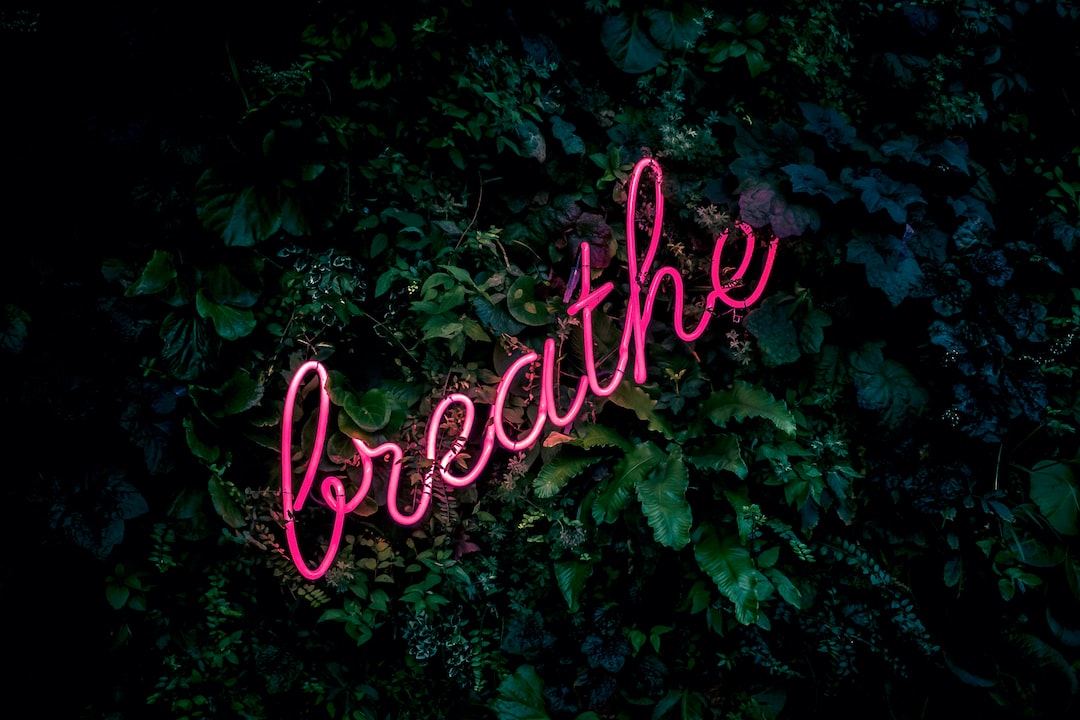
 Beginners Guides4 weeks ago
Beginners Guides4 weeks agoDesigning Your Retreat Center – Essential Tips
-

 Beginners Guides4 weeks ago
Beginners Guides4 weeks agoAre Retreats Profitable
-

 Decor2 weeks ago
Decor2 weeks agoWhat Is Eclectic Home Decor





